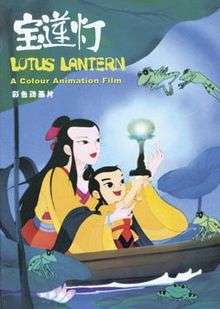Lotus Lantern
Lotus Lantern (Chinese: 宝莲灯; pinyin: Băo lián dēng) is a Chinese animated feature film based on the Chinese fairy tale, The Magic Lotus Lantern, produced by Shanghai Animation Film Studio.
| Lotus Lantern | |
|---|---|
 | |
| Directed by | Chang Guangxi |
| Produced by | Sheng Chongqing |
| Written by | Wang Dawei |
| Starring | Jiang Wen Xu Fan Ning Jing Chen Peisi |
| Music by | Jin Fuzai |
| Edited by | Gong Liming |
Production company | |
Release date | January 1, 1999 |
Running time | 85 minutes |
| Country | People's Republic of China |
| Language | Mandarin |
| Budget | RMB 12 millon |
Plot
The story is based on the traditional Chinese folklore about a boy named Chenxiang. His mother, Sanshengmu, was a goddess and his father, Liu Yanchang, was a mortal. Since their marriage was forbidden, his maternal uncle, Erlang Shen, who was a god, punishes them by killing Liu Yanchang. Sanshengmu escapes and gives birth, but Chenxiang grows up without knowledge of his ancestry. Sanshengmu possesses a magical Lotus Lantern whose light can scare away evil. When Erlang Shen, a strict and powerful god, kidnaps Chenxiang, Sanshengmu fights to save him.
Unfortunately, Erlang Shen is victorious and Chenxiang is forced to live in his palace on the sacred mountains. Erlang Shen then imprisons Sanshengmu beneath a mountain for her crimes. Although he is quite young, Chenxiang manages to escape from the palace, taking the magical lotus lantern that Sanshengmu lost during the battle.
After surviving adventures with many beloved characters of Chinese mythology, Chenxiang finally matures into a courageous young man who must battle Erlang Shen to win Sanshengmu's freedom and fall in love at the same time.
Main characters
- Chenxiang: Half-god boy. His mother is a goddess and his father is a mortal. He gets through tons of adventures to win his mother's freedom from his uncle Er langshen.
- Sanshengmu: Powerful Goddess who possesses a magical lotus lantern. She fell in love with a mortal and gave birth to Chenxiang. For which she is imprisoned beneath Hua Mountain.
- Er langshen: Er-lang Shen may be a deified version of several semi-mythical folk heroes who help regulate China's torrential floods, dating variously from the Qin, Sui and Jin dynasties. A later Buddhist source identify him as the second son of the Northern Heavenly King Vaishravana.[1]
Background
The production took four years and required over 150,000 animation cels and over 2,000 painted backgrounds. It was the most popular film in China in 1999 and influenced china's animation a lot which later makes a great difference to the world
DVD
Released in 2004, it contains English- and Japanese-language soundtracks along with the original Mandarin dialogue.
See also
- List of animated feature films
References
- "China Insight Series: Chinese Movies 3-2, News, La Trobe University". Latrobe.edu.au. 2015-07-07. Retrieved 2016-11-17.